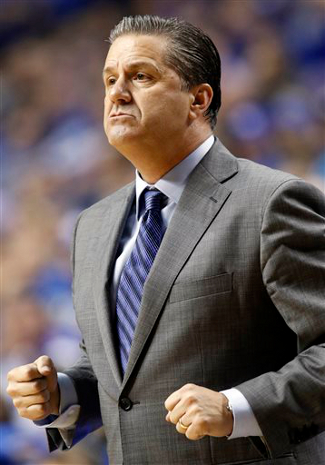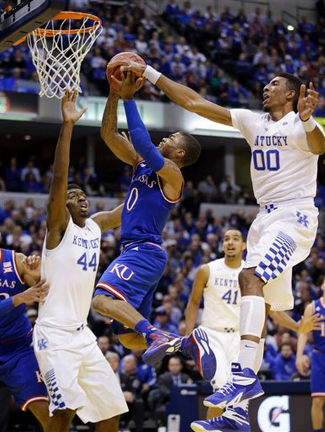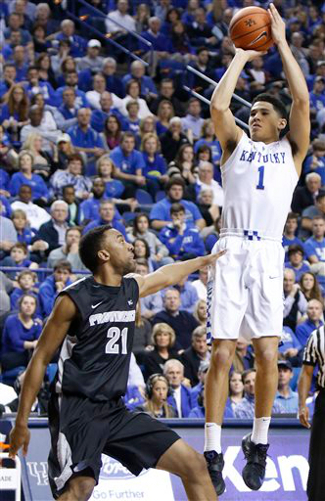Rupp Arena | Lexington, KY | Tip: 6 P.M. CT | TV: ESPN Vegas: Kentucky -11.5 | KenPom: Kentucky, 65-55 (86%) The buzz around this year’s Longhorn team has been strong since the moment last year’s team was knocked out in the NCAA tournament’s Round of 32. That only intensified in late April when Myles Turner decided to attend UT, and the national excitement continued to grow as the Horns notched neutral site wins over Iowa and Cal, and a true road win against UConn. As the hype train gained speed, one game was repeatedly mentioned by every announcer and publication. After weeks of build-up, that big game is finally here. The matchup of the massive frontcourts of Texas and Kentucky is now just hours away, and although the absence of Isaiah Taylor will put a disappointing asterisk on the box score, that buzz and excitement is still in the air. Considering Taylor’s absence and the tough road environment, both Vegas and the legendary Ken Pomeroy don’t give the Longhorns much of a chance. Still, college hoops writers have pointed out all week that if any team is going to match up with this Kentucky juggernaut, the Longhorns are your first pick. By the numbers
John Calipari is pumped about this year’s UK team When you look at the statistics for the Wildcats, it’s hard to find a negative. It’s almost as if this is a video-game team where the programmers just decided to give everyone a 99 rating in every category, and you ended up with an entire roster of gigantic players with freakish athleticism. The only statistical areas measured by Pomeroy in which Kentucky is not ranked in the nation’s top 50 are free-throw percentage (65.3%; 253rd), three-point percentage (32.3%; 207th), and effective field-goal percentage (52.5%; 74th), with that last percentage actually being dragged down by the second one. Overall, the Wildcats have the nation’s third-most efficient offense in terms of adjusted efficiency, with Pomeroy reporting 1.136 adjusted points per possession. On the other side of the court, they post the nation’s second-best adjusted defensive efficiency, averaging 0.839 adjusted PPP. Every single team that has played Kentucky this year has posted their worst offensive numbers in that game, with Montana State managing just 0.398 PPP in an 86-28 blowout. If you take a look at the tempo stats for UK, you can see just how difficult it is for opponents to limit their effectiveness. On the year, the Wildcats have an adjusted tempo that is in the bottom third of Division I, with an average of 65.2 adjusted possessions per game. In terms of actual possession length, Kentucky’s 16.1 second average on the offensive end is 42nd shortest in D-I. Against Kentucky’s defense, the average possession length is 19.8 seconds, which is the 23rd longest. Opponents have tried to slow the game down by being patient on offense, but Kentucky is so explosive on the other end that they can still score points in a hurry. Meet the Wildcats There is never a shortage of talent in Lexington, and that is certainly the case this season. With Aaron Harrison (No. 2), Andrew Harrison (No. 5), and Willie Cauley-Stein (No. 15) all deciding to return for another season at UK, Coach John Calipari suddenly found himself with more great players than he’d planned on having. The team boasts nine McDonald’s All-Americans and eight returning players, three of them starters. With the abundance of riches on his bench, Calipari decided to test out a platoon system in their August trip to the Bahamas. Named the Blue Platoon and the White Platoon, Calipari’s two stacked groups of five provide him with the chance to provide complete “reinforcements” — he prefers that term to “subs” — at every media timeout. With the second platoon easily being skilled enough to start at any school in the country, the Wildcats have waves of talent that allow them to keep their energy levels high as they wear down opponents over 40 minutes. The Blue Platoon starts the game, and consists of the Harrison twins, Cauley-Stein, Alex Poythress (No. 22), and Karl-Anthony Towns (No. 12). Andrew Harrison runs the point, and is coming off a season in which he struggled with turnovers and oftentimes made his frustration visible on the court. As a sophomore, his turnover rate is still north of 20%, but he carries himself with more confidence, and still dishes out dimes on nearly 29% of the buckets scored when he’s on the floor. His brother, Andrew, is the Blue Platoon’s shooting guard. Andrew instantly became a Kentucky legend with his clutch three-point shooting in last year’s NCAA tournament, which saved the team in consecutive wins over Louisville, Michigan, and Wisconsin. This year, he’s only taken 13 threes, but has connected on 38.5% of them. In addition to his three-point prowess, Andrew is easily able to get inside and score, thanks to another gear that makes him look like he’s just gliding with the ball. He has good body control, so he can absorb contact in the air and still make a shot, and he also scores a few fast break buckets each game thanks to his quick hands on the perimeter.
Marcus Lee is one of many UK shot blockers Inside, Poythress is one of the team’s old, grizzled veterans, despite being only a junior. He has great hops and timing to block shots, and will often wipe away an opponent’s fast break opportunity by racing back and swatting the layup attempt from behind. The 6’8″ big man has missed a pair of games this year due to illness, and is currently shooting just 35.5% from the field, but his defensive contributions and solid rebounding still make him a factor in every game. The other old man in the Blue Platoon is Cauley-Stein, a 7-foot junior who had to watch the team’s Final Four run after suffering an ankle injury in the Sweet 16. That injury led to this awesome outfit at the title game, and it also encouraged Cauley-Stein to return for another season, despite being projected in the first round of the NBA draft. He runs the floor well in transition, moves well laterally when defending the post, and provides an intimidating, shot-blocking presence down low. The 6’11” freshman Towns rounds out the Blue Platoon, and he’s already made a huge impact on both the Wildcats and the national basketball scene. He currently has the nation’s second-best block rate, as he swats more than 18% of the two-point shots attempted when he’s on the court. He also rebounds well on both sides of the court, with his offensive and defensive rates both ranked in the Top 50. One of the most impressive things about his game has been his ability to look to the opposite wing when doubled in the post, as he has repeatedly set up teammates for wide-open threes with his quick, timely passes. The White Platoon is run by 5’9″ freshman point guard Tyler Ulis (No. 3). Although he’s the smallest player by far and has only played seven collegiate games, Ulis has been absolutely phenomenal. He is a lightning-quick pest on defense, practically living in the shirt of the opponent unlucky enough to be guarded by him. He has a steal rate that is ranked in the Top 50 nationally, but he’s also been responsible for turnovers by causing five-second violations and forcing bad passes. On offense, he’s just as fast with the ball as he is on defense, and can quickly get a shot off, both in catch-and-shoot and pull-up situations. Although he’s taken just 14 attempts on the year, Ulis is the team’s most accurate three-point shooter with a 57.1% mark.
Devin Booker is a three-point marksman Although Ulis has the best mark so far this season, the team’s best three-point shooter is probably fellow freshman Devin Booker (No. 1). At 6’6″, roughly two-thirds of his shots come from behind the arc, but he’s also shown the ability to slash inside and hit a nice floater when defenses play him too tightly on the perimeter. Booker had a bumpy start on three-point shooting this year, which culminated in an especially tough 1-for-6 night against Kansas in the Champions Classic. Since then, he’s been practically automatic, knocking down 13-of-19 triples in the last four games. Sophomore Marcus Lee (No. 00) is a fantastic shot blocker with great hops. He moves really well on defense for a 6’9″ guy, which allows him to provide pressure even when his man floats out to the perimeter. He hasn’t seen quite as many minutes as the rest of the White Platoon, a situation that will likely continue until his free-throw shooting improves. Currently just 1-for-8 from the line, Lee won’t be able to play late in close games if teams can target him for fouls. Free-throw troubles are also a concern for 7-foot sophomore Dakari Johnson (No. 44). After a promising start in two exhibition games, where he made 7-of-9 at the stripe, Johnson has made just 60.5% of his free throws during the regular season. Last year, he made just 45%. That’s a big problem for a guy who draws fouls at the eighth-highest rate in all of Division I hoops. Although Johnson’s free-throw shooting hasn’t improved, he does look much better running the floor in transition this year, and is still a shot-blocking and rebounding machine in the middle. Teams have tried double and triple teams already this season, but he’s showed patience and poise against the pressure, and is still often able to score in those situations, thanks to a nice little hook shot. Freshman Trey Lyles (No. 41) is the final member of the White Platoon and the ten-man rotation. Named Mr. Basketball in the state of Indiana last year, Lyles has already showed off a versatile skill set in his short collegiate career. At 6’10”, he’s still able to knock down outside shots, and can move well enough on defense to guard on the perimeter. Lyles has shown great body control for some impressive shots around the paint, is easily able to create his own shot in face-up situations, and of course can post up down low. Keys to the Game Even with Taylor at the point, Texas would have needed to execute extremely well for 40 minutes against an incredibly talented and deep team in one of the most hostile environments in the country, just to have a shot at escaping with a win. Without their point guard, it’s not a stretch to say that the Longhorns will need to play a nearly-perfect game to claim a massive road upset tonight. The four keys below are just a few of the many areas in which Texas will need to execute. 1. Dictate the tempo – With reinforcements coming in roughly every four minutes, Kentucky always has fresh legs late in the game. That depth also allows them to play high-pressure defense for 40 minutes, which wears on their opponents throughout the game. Add in the fact that the Longhorns are thin in the backcourt, have a pair of frontcourt players in Cameron Ridley and Prince Ibeh who will likely struggle against UK’s bigs, and that Texas is playing its third game in six days, and you can see why Texas needs to limit the possessions tonight. If the Longhorns have poor shot selection and don’t exercise patience on the offensive end, it’s going to cost them dearly in the form of fatigue late in the game. 2. Protect the paint – Although Kentucky has some three-point shooters, the bulk of their scoring comes down low. Texas is well equipped to give the Wildcats a battle in the paint, and they will need to make it very difficult to score down low for UK. If the Longhorns can force Kentucky to take mostly jumpers, they should be able to slow down the highly-efficient Kentucky offense at least a little bit. 3. Limit second chances – Forcing Kentucky into taking jump shots won’t make much of a difference it the Longhorns don’t win their defensive rebounds. Kentucky has the nation’s best offensive rebounding percentage, as they have reclaimed nearly half of their missed shots this season. If Texas allows UK extra opportunities and easy putbacks tonight, the chances for an upset will be slim. 4. Take care of the ball – The Kentucky defense is unrelenting, as Providence quickly learned in their loss at Rupp this weekend. The Friars did an excellent job dictating the pace of the game and forcing the Wildcats to take more jump shots, which allowed them to hold a lead into the second half. Everything quickly fell apart for PC, though, as the Wildcats forced a flurry of turnovers and scored fast break points at will. Kentucky’s stable of huge big men allow their guards to provide extra pressure on the perimeter, since the big men can easily clean up any dribble penetration with a blocked shot. Add in the fact that the Harrisons, Ulis, and Booker also all have quick hands, and it’s very difficult for opposing guards to hang on to the ball. Compounding the problem for offenses is the fact that Kentucky’s big men are all athletic enough to switch ball screens on the perimeter. Combine all of those factors, and it is very difficult for teams to find much success against the Wildcats. The Longhorns have recently had issues with sloppy play and turnovers against defenses not nearly as frustrating as that of Kentucky. If Javan Felix and his teammates cannot take care of the ball tonight, an intriguing matchup of Top 10 teams could quickly turn into a rout. |











